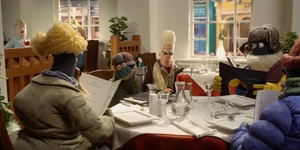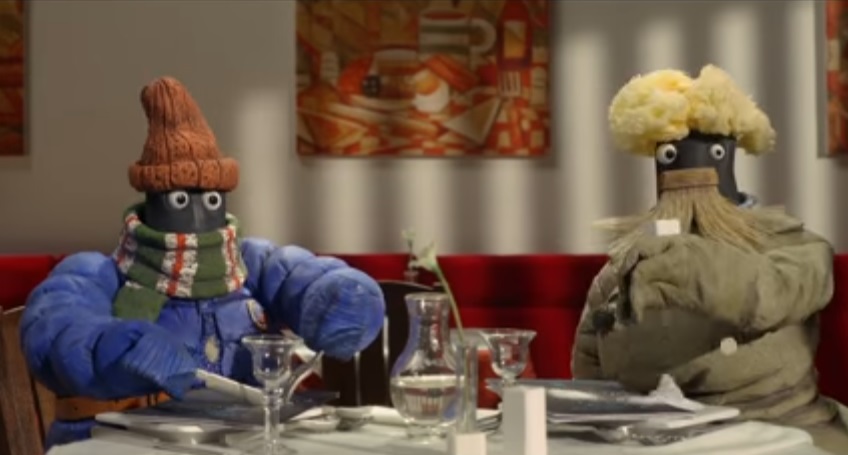
Starzak and Burton challenge our perceptions of human and animal intelligence in Shaun the Sheep The Movie. Aardman excel in casting the animals as intelligent and exasperated by humans, meanwhile humans are portrayed as less so, and oblivious to animal antics happening directly in front of them. The scene in which the sheep dine in a fancy restaurant combines animated animals with classic tropes of silent comedy and visual gags to create slapstick comedy mocking tension between human and animal intelligence. The farcical nature of slapstick mocks this inversion of how we assumed each species to be, and the arrogance of human’s superiority. The sheep are balanced between anthropomorphised and animalistic in the restaurant, challenging where the boundary of human-animal is.
The slapstick in the scene mocks the ridiculousness of the situation at hand; a stereotypically dumb flock of sheep have sat down for a haute cuisine dinner in fancy restaurant. Imitating something so commonplace is hilarious, making the humans look foolish. The notion of fine dining and snobbery is undermined by a flock of sheep. It is ironic that haute cuisine often serves unconventional meat such as mutton an offal, yet the livestock has sat down for a meal themselves.

The sheep are not entirely anthropomorphic, they exhibit humanlike behaviour and understand societal conduct, yet they are not entirely successful. The small errors they make in their imitation, in fact, have greater comedic value than if they had seamlessly mimicked them. An animal doing human activities is hilarious, but putting a cap on anthropomorphism, with the animal failing slightly, adds a goofiness which elevates the comedy further still. Their blunders show traces of their stereotype.
The imitation is immediately established through the sheep’s attire; their outfits are mismatched and include odd objects, like a broom for a moustache. The result is ludicrous; the sheep wearing human clothes alone is comedic, yet their unknowing mistakes seem so apparent to us, so their foolishness increases humour. There is an understanding that both the sheep and the audience feel wiser than the other, so each feels superior. Their boldness is continued through their engagement with menus, confidently eating and seasoning them.
Diegetic sound enhances the silent comedy effect. Both human and sheep communication is reduced to a small amount of grumbling noises alluding to speech – virtually silencing both. By limiting the communication of both species they are placed on a more equal level. By restricting voices, the comedy is all physical, like the classic genre.
Like in silent comedy, the music reflects action. A piano playing classical music establishes the atmosphere, contrasting the country dwelling animals – distancing them from their usual surrounding. The piano signals the beginning of a typical silent comedy sequence. As the scene progresses the music builds, reaching a crescendo as Shaun’s identity is revealed. It is particularly amusing that the piano is diegetic, played by a character in the scene, as the coincidence of this is ludicrous.
Shots used in this sequence exaggerate their imitation of human behaviour. The back and forth between close shots of the celebrity and wide shots of the sheep build tension. A close shot of him is immediately echoed in a wide shot as the sheep copy him. The back and forth builds tension, as we find it incredulous that the humans still haven’t realised. The more the sheep get away with it, combined with the switching shots, creates a climax, waiting for the tension to release. Their forced anthropomorphism is made explicit here, drawing attention to their impersonation